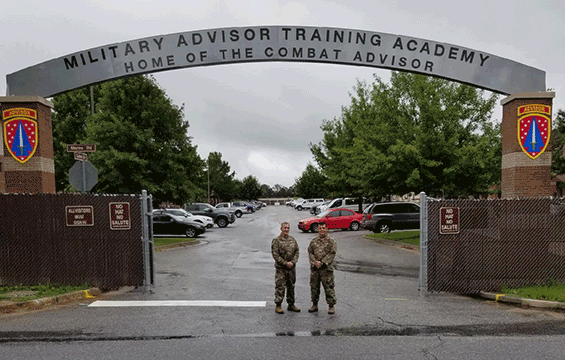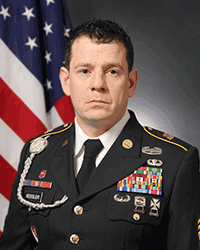Ohio National Guard Soldiers first in state to graduate |
||
Maj. Brett Green (left) and 1st Sgt. Izzet Kessler, both members of the Ohio Army National Guard's 5th Battalion, 54th Security Force Assistance Regiment, 54th Security Force Assistance Brigade, learned how to train foreign military forces at the U.S. Army's new Combat Advisor Training Course this summer at Fort Benning, Ga. The OHARNG's new 5-54th SFAR was activated Sept. 1, 2018, along with four subordinate companies. (Courtesy photo) |
||
COLUMBUS, Ohio (12/04/18) — For almost a month, Maj. Brett Green and 1st Sgt. Izzet Kessler, both members of the Ohio Army National Guard’s new 5th Battalion, 54th Security Force Assistance Regiment (SFAR), 54th Security Force Assistance Brigade (SFAB), learned how to train foreign military forces at the U.S. Army’s new Combat Advisor Training Course (CATC) this summer at Fort Benning, Georgia. The 28-day course centered on learning how to assist and coach a Foreign Security Force (FSF) leadership team, working with a linguist and other critical skills vital to the new OHARNG battalion headquarters, which was activated on Sept. 1 along with four subordinate companies. “I thought the training was very good overall,” Green said. “There were some challenging aspects, the main point being the ambiguity of the process, which was by design. A lot of the training revolved around working together in your small team and drawing out the strengths of each team member to facilitate success.” SFABs are specialized units with a core mission to conduct training, advising, assisting, enabling and accompanying operations with allied and partner nations. They allow the Army to reduce, over time, the demand for conventional brigade combat teams for combat advising. Of the six formed brigades, only the 54th SFAB, headquartered in Indiana, comprises Army National Guard members. “We are not to be out on the point in this mission, but rather helping the FSF build their capacity and capabilities to perform missions on their own,” Green said. “The general consensus is to work ourselves out of a job, meaning get the FSF to levels where they are self-sufficient in all areas, such as logistics, operations, intelligence and communications.” Lt. Col. Andrew Stone, commander of the 5-54th SFAR, said that he is extremely proud of Green and Kessler. “The 5-54th has 30 advisor positions who must go through the CATC to be qualified; we have to do this over the next two years in order to prepare for our available year,” Stone said. “Having two senior leaders qualified so early will allow them to build the training programs that will set all the other attendees up for success.” The chief of staff of the Army’s vision for the SFABs is to staff them with tough, mature, emotionally-intelligent officers and noncommissioned officers who can train foreign security forces. National Guard members are able to draw from a wealth of experience, both in the military and other areas, which will prove crucial with this unique mission. “Guardsmen bring unique civilian skills not found in the active component,” Stone said. “For instance, Maj. Green is a high school educator, and 1st Sgt. Kessler works in therapy; both of their civilian careers make them perfectly suited for taking disparate, young, poorly-organized groups of security force personnel in foreign countries and building them into cohesive teams.” SFAB Soldiers are selected based on qualifications and experience, however these volunteers are making an investment in their future. The training they conduct, CATC for example, will add a set of skills, knowledge and operational experience that will be in high demand by the joint force for years to come. Learn more about the requirements to become a member of an SFAB |
||
| |


